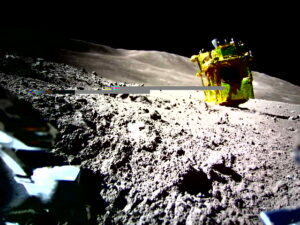SLIM Survives Another Lunar Night
The Japanese space agency’s SLIM lunar lander defied the odds again, surviving not just one, but two bitter cold lunar nights and sizzling hot lunar days. The Smart Lander for Investigating Moon has sent back another new image from its navigation camera two months after a sporty landing that initially suggested its lifetime would be sharply limited.
The Japan Aerospace Exploration Agency (JAXA) broadcast the astonishing news of SLIM’s survival on X (formerly Twitter), including a new image from its navigation camera.
Last night, we received a response from #SLIM, confirming that the spacecraft made it through the lunar night for the second time! Since the sun was still high and the equipment was still hot, we only took some shots of the usual scenery with the navigation camera. #GoodAfterMoon pic.twitter.com/5BjIr7vxMG
— 小型月着陸実証機SLIM (@SLIM_JAXA) March 28, 2024
SLIM set down on the lunar surface on January 19, 2024 Eastern Standard Time (January 20 in Japan), but after losing an engine during descent it landed upside down with most of its solar panels facing away from the Sun.

Without sufficient power, the lander was expected to operate for only a short period of time, but sent back images from one of its navigation cameras as well as a partial image using its more capable Multi Band Camera (MBC).
Engineers hoped that as the Sun angle changed in subsequent days enough sunlight could reach the panels to allow further imagery. Indeed, that’s exactly what happened and before the 14-day lunar night descended they obtained the rest of the MBC scan.
SLIM is one of a new generation of comparatively inexpensive lunar landers that rely only on solar cells, not radioistopes, for power and warmth. The trade-off for the lower cost is a short lifetime since batteries and electronics are not designed to survive 14 days of frigid cold about -250°C (-418°F).
Two other new-generation spacecraft have successfully landed on the Moon in the past year. As expected, India’s Chandrayaan-3 and the U.S. Odysseus, or Odie, built by Intuitive Machines as part of NASA’s Commercial Lunar Payload Services (CLPS) program, did not wake up after their lunar nights. Intuitive Machines acknowledged Odie’s fate in a series of posts on X.
As previously announced on February 29th, our IM-1 mission ended seven days after landing, as Odysseus’ mission was not intended to survive the harsh temperatures of the lunar night. Before its batteries were depleted, flight controllers tucked Odie into a configuration that…
— Intuitive Machines (@Int_Machines) March 23, 2024
As of March 23rd at 1030 A.M. Central Standard Time, flight controllers decided their projections were correct, and Odie’s power system would not complete another call home. This confirms that Odie has permanently faded after cementing its legacy into history as the first…
— Intuitive Machines (@Int_Machines) March 23, 2024
Only SLIM again responded to commands and not just after the first lunar night, but now after a second.
The imagery being acquired is only from a navigation camera, not the MBC, and since the camera cannot be moved and the surface of the Moon doesn’t change, it looks much the same.
As JAXA said in one of its posts on X (translated by Google): “There is no rain or wind on the moon, so if you take a photo taken in the same direction, the arrangement of rocks and topography will hardly change. The crater that I targeted when I landed has had the same shape since ancient times. Since you can’t move the navigation camera, you’ll probably continue to get photos where nothing is moving at all, but keep an eye out for changes in the length of the shadows!”
月の上では雨も風も吹かないから、同じ方向の写真だと岩の配置や地形はほとんど動かないよ。僕が着陸時に目標にしたクレーターも大昔からずっと同じ形をしているんだ。航法カメラは動かせないので、これからも基本は全く何も動いていない写真になるはずだけど影の長さの変化とかに注目してみてね! pic.twitter.com/TJzRmNjTHt
— 小型月着陸実証機SLIM (@SLIM_JAXA) March 28, 2024
JAXA said that although “some temperature sensors and unused battery cells are starting to malfunction,” most of the “functions that survived the first lunar night” also survived the second.
According to the acquired data, some temperature sensors and unused battery cells are starting to malfunction, but the majority of functions that survived the first lunar night was mantained even after the second lunar night! #SLIM #GoodAfterMoon #JAXA
— 小型月着陸実証機SLIM (@SLIM_JAXA) March 28, 2024
User Comments
SpacePolicyOnline.com has the right (but not the obligation) to monitor the comments and to remove any materials it deems inappropriate. We do not post comments that include links to other websites since we have no control over that content nor can we verify the security of such links.